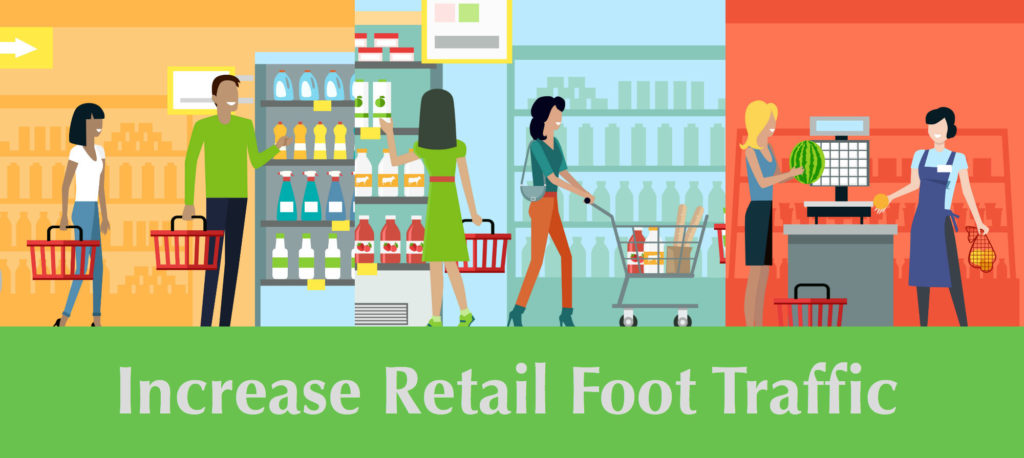 The number one complaint among retailers isn’t regarding abandonment rates, purchase size, nor managing the costs of operation. Most retailers are looking to simply get more customers through the door.
The number one complaint among retailers isn’t regarding abandonment rates, purchase size, nor managing the costs of operation. Most retailers are looking to simply get more customers through the door.
Customers have more options than ever, with e-retailers always being available and smaller, previously web-only outlets opening smaller locations across the United States and Canada. The modern customer is well-informed and will weigh their choices carefully before making the trip or placing their order.
If you’re confident in your store’s ability to convert customers, you too may simply be looking to attract more people to one of your retail stores. In this case, consider these potential customers and their needs, and what brings in your current customers. What is already driving your foot traffic, and how can you scale this into a full-fledged strategy?
That is the key to driving foot traffic – customer loyalty.
Repeat Business: The Cornerstone of Retail
As you may already know, repeat customers spend far more than new ones. Bain & Co. followed 522 different apparel store customers’ shopping habits over time. By the fifth trip, they were spending 40 percent more than their initial purchase. By the 10th one, these customers went to check out with a cart 80 percent larger in value than the first one.
The root of a retailer’s profitability is having their customers come back. Everyone has a first time in the store, and new foot traffic is its own challenge. The good news is that incentivizing a previous customer to come in costs only a fifth as much as attracting new leads. If your goal is to boost the number of customers visiting your store, repeat business is the cost-effective option.
Customer Loyalty is the Retailer’s Responsibility
The phrase “customer loyalty” is a bit backwards, as neither the customer nor their sense of loyalty is really what is determining if they are coming back. It is solely on the retailer to ensure that their customers have a positive brand experience and have plenty of incentives to return.
Customers who have their needs met at one store will usually continue to stay with that brand unless they have a poor customer service experience. Those customers who have only positive experiences will inevitably begin to promote the retailer through word-of-mouth, social media engagement, and even exclusivity with the brand. Thus, customer loyalty becomes a matter of consistency.
Methods for Customer Retention
There are numerous business practices that are purported to help bolster your returning customer base. More often than not, the strategies that work initially come across as common sense. That’s because most of the best methods for ensuring your customers come back are simply ensuring that they have a consistent, convenient, and ultimately positive experience.
Here are a few ways you can meet your customers’ needs better across all your store locations:
Customer Loyalty Programs
Some may believe that customer loyalty programs are a gimmick, but the facts are clear: customers who sign up for a loyalty program are more likely to come back, and generate up to 18% more revenue than those who don’t join. Most modern POS systems already come with a variety of automated loyalty programs equipped.
These programs aren’t necessarily showing your customers’ loyalty to your brand, it’s about showing your brand’s loyalty to your customers. When customers feel valued for repeat business, they are almost certain to come back.
Click and Collect
Another method that is victim of being dismissed as a novelty program, click-and-collect is surprisingly successful in what it’s meant to do. Every customer that participates is a customer saved from defecting to an ecommerce platform. What’s more, if they have a good click-and-collect experience, they are more likely to engage in the program again.
The best part: half of the customers who come in for click-and-collect are liable to purchase other items while at the store. A fifty percent conversion rate on a customer who was almost lost to Amazon is a worthwhile program to pursue.
Branded Customer Service and Training
Beyond all of the dictated programs is the central component of a good customer experience: customer service. Your employees are at the forefront of your branding. Everything from the initial greeting to the process of checkout entails at least one employee, either directly or indirectly.
Even if a customer chooses to checkout via kiosk and never even speaks to your staff, something as simple as a clean store and organized shelves demonstrate your brand – and employees’ – values.
Therefore, ensuring that even your seasonal employees are properly trained becomes a priority in ensuring your brand is represented. As we showed earlier, one bad customer experience is enough to bar many customers from ever entering one of your stores again. Focus on creating a positive environment and employing a solid training program or system to make sure your staff understands your goals and brand.
Boosting Foot Traffic Across All Locations
Like we mentioned before, the key to customer retention is consistency. That means that the omnichannel, IoT-friendly framework you’ve created in some stores should be emulated across all of your locations. Whether you are expanding to new store locations, or upgrading old ones to meet modern customer needs, making sure that each has a robust, integrated IT infrastructure is the first step in building customer loyalty.
Contact Worldlink Integration Group if you’re looking for help implementing your latest IT projects, and find out how you can #WinWithWorldlink.